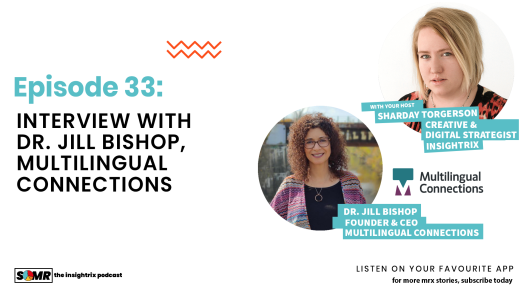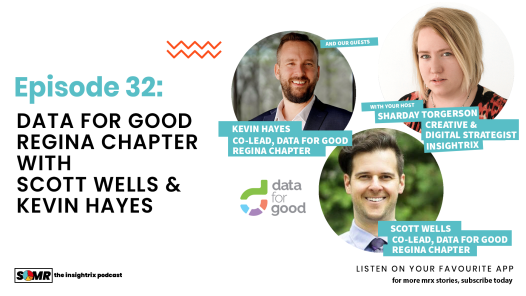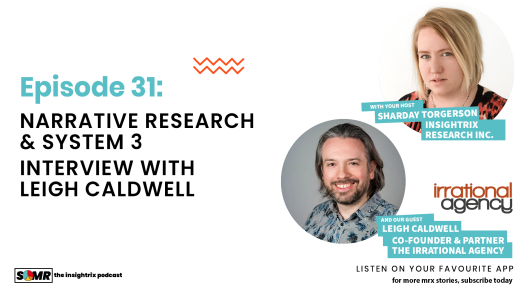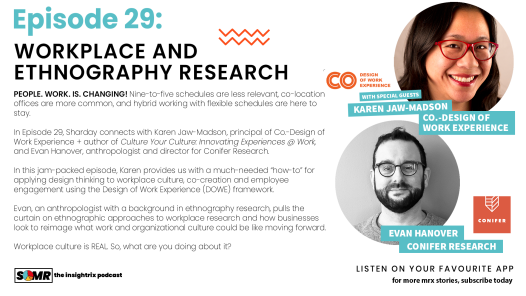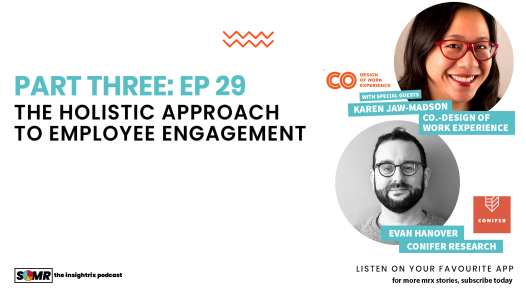Meaning that for some votes, being there virtually in your pajamas is something that you may very well just be able to do. Online voting brings a unique experience to the voting process. It improves voter confidence and accessibility while maintaining the accuracy and security of the voting process, and has an added bonus. In many cases, online voting also provides for the immediate and accurate tabulation of voting results.
Hello, I’m Duncan McGregor, the marketing and communications coordinator at Insightrix Research in Saskatoon, Canada, and your podcast host. In this episode of Stories of Market Research, we’re talking about online voting, how it’s used, what organizations are using it, concerns, benefits, and more. First, we’re talking with John Tzupa, CEO of the Saskatchewan New Democrats. The Sask NDP recently contracted Insightrix to assist them with an online nomination project.
And we speak to John to learn all about how it went and the benefits he sees in online voting. Then John shares some of his thoughts for others who may be looking at an online voting solution for their organization. Then, later in the episode, we speak to Insightrix Project Manager, Stacy Bernales, and Insightrix Research Director, Lang McGilp, about online voting in general and how a market research firm like Insightrix ended up in the online voting business, how online voting works, what organizations are using it and what the future of online voting may hold. All that in more on episode 22 of Stories of Market Research: The Insightrix Podcast.
[INTERSTITIAL MUSIC] [INTERVIEW SEGMENT #1] [DUNCAN] Hi, John, thanks for coming on the podcast. [JOHN] Hi Duncan, thanks for having me. [DUNCAN] It’s great to have you on. I’m really looking forward to talking about the online voting the Saskatchewan NDP did recently with us. If you could, could you provide some background to our listeners on what led the Saskatchewan NDP to conduct your nomination contest through online voting with Insightrix? [JOHN] Yeah, for sure. We all know that here in 2020 we’ve been faced with the realities that have come with a pandemic and COVID-19. In early March, the first case was identified in Saskatchewan. And at that exact moment, we were gearing up for a potential snap election. And we’re also working towards getting ready for the 2020 election this whole year. The election has been scheduled for the fall of 2020 for some time. So we were organizing nominations and so on.And at the beginning of March, with where things were at, we implemented a physical distancing policy and decided to postpone all in-person events indefinitely, and they remained postponed to this day. And because the guidelines are now in place that would require them to be postponed. They weren’t at that exact moment. But then, they came. We still need to get ready for an election. We need to nominate our candidates.
And we added a number of contested nominations that were scheduled to take place in the month of March and that we wanted to conduct. And we wanted to make sure that they were inclusive for our members and that we were confident in them being a fair election. And that we were able to conduct them, implement using physical distance. And we saw doing something that allowed for online, a little bit of phone voting, to be a good fit for us at that exact moment in time.
[DUNCAN] Right on. So, voting occurred both online through both of our secure mobile-optimized voting platform and through the telephone, through inbound calling. How did NDP members find the process itself? [JOHN] So overall, people found it to be very easy, especially those who used online voting because it was very straightforward. They received the link, they clicked through, they conducted their vote, and it was simple as that. For some people who did it over the phone, it was more challenging at times because it was often that they’d have to leave a voicemail. But we anticipated that there would be some challenges for them.So, one of the most important things for this to be a successful project was that the voting not occur over just a two-hour period, like a traditional nomination. That we allow for five days of voting. And that allowed us to address the concerns that people would have had. And overall, people found it to be a very easy process. We had great participation. And yeah, it went quite well.
[DUNCAN] Well, other than telephone, did you see any unique challenges that you faced while you worked together? [JOHN] Well, I guess the biggest challenge, working with the provider early on, is that we were trying to make it clear how we had felt that there would be a volume of need for telephone voting, that wouldn’t have been traditionally what the provider would have experienced. So they had felt that it would probably have been a bit less than it was. The numbers ended up being quite close to what we had predicted, but it did end up being a bit bigger volume. So there was challenges that it took. We were very fortunate that we have the five-day period because it took a couple of days to adjust for everything to be caught up on in regards to the phone voting.But overall, with the online voting, it was very straightforward. The odd person didn’t receive something. We identified that there might have been a letter missing in the email address or whatever. We worked very closely with the provider. We had great communication between us and the provider. So we were able to provide good service to people if they contacted one or the other. That we could check with each other verify information and make sure that we were very inclusive of making sure that anyone that was eligible to vote was able to do so.
[DUNCAN] Well, that sounds like it went pretty well. Did you notice any surprise benefits while you were doing process in this new format? [JOHN] One of the benefits is that especially by being able to extend the voting period, you give people more opportunity to participate and then you end up seeing an increase turnout. Normally, with our nomination meetings, we’ve held them in-person, but you had to be there in-person and be there at the time that voting was to take place. In this case, voting was able to happen over a five-day period. And it really allowed for more participation and we saw an increase in turnout as a result. [DUNCAN] Well, that’s cool. So, you actually had better representation as a result of doing it online, just because it was just that much more convenient? [JOHN] Well, if we’d done it online for a one-hour period, like we do the in-person ones… [DUNCAN] Fair. [JOHN] … that would still have been limiting, but by being able to change the nature of what we’re doing. So taking this process away from a traditional in-person meeting and making it an online process absolutely opened it up to more people and allowed us to make it a more inclusive process for our membership, and it allowed for way more people to be able to participate in the process, which is very encouraging. It was exciting for us. [DUNCAN] That’s awesome. Yeah. It doesn’t have really the taboo around it that it used to have either. Right? It still has that level of validity that regular voting processes would have. It’s just a different way of doing it. Right? [JOHN] Yeah, we also have other processes that come into our… like what makes somebody eligible, what steps were taken for them to become a member, and all those things. [DUNCAN] Of course. [JOHN] So, collectively with those checks, and the advancements of how both technologies exist to make it easy to track who has done what, and everything else. And just people’s overall familiarity and comfort level with technology has really evolved, allowing this to be a more successful process. But in our case, in the NDP, people weren’t completely green to a vote that was done online. We’ve had a couple of leadership contests, both federally and provincially, where people have been able to participate in this way. This was just the first time that we did it on a local constituency nomination level. [DUNCAN] Well, that’s really awesome. So, is this a process the NDP in Saskatchewan may look to do again in the future, even without similar concerns around COVID? [JOHN] So, as I said, so using online voting to conduct elections in the NDP has been around for, I guess, 11 years now that there has been in these some components of online being allowed to be involved. And both through federal and provincial leadership contests. But on the local level, we hadn’t before. And this would absolutely be something that would be contemplated moving forward.In Saskatchewan and in many places, some electoral districts make up very large geographies, which make it very hard for people to gathering in one place if you were to do a very traditional in-person nomination meeting in lots of these areas. So it’s a way to remove geography as one of the challenges of organizing events. And for the time being, physical distancing is going to be a challenge that we’re operating under for some indefinite amounts of time, but at least for several months still.
[DUNCAN]Yeah. Yeah, so having that success with online voting in this one contest, and as you said, throughout other experiences, what advice would you give to a similar organization that may be contemplating this kind of approach in the future?
[JOHN] So, we believe that there’s lots of benefits of it. The entry point is very easy. People can participate from home. You can improve the contact lists that you have with people to make sure that they’re providing the contact information that’s relevant to the way that the correspondence is going to be received for them and how they’re going to vote. So emails, cell phones, et cetera. I guess one of the big things is that if you’re going to go down this road; like any road, really, when you’re operating on something where you’re going to be; needing to keep close track of who was eligible to participate and who was participating in everything else is that you need to make sure that you have the appropriate timelines for the project to be successful and that you’re giving an adequate amount of time for this type of method be utilized in its best way. And so, for example, a voting period of five days was, in our opinion, a very good amount of time, and that that would lead to a more successful outcome than reducing it to one day. [DUNCAN] And that’s actually a really good takeaway for other folks. Just make sure that you’ve got a lot of time or the time that you need to get it done. So that’s great. I really want to thank you for coming on the podcast and explaining this to our listeners. It’s really great to have you on. [JOHN] Well, thanks for having me. [INTERSTITIAL MUSIC] [INTERVIEW SEGMENT #2] [DUNCAN] So I’m here with Stacy Bernales and Lang McGilp. Thanks for joining me, guys. Really glad to have you here. [STACY] Thanks for having us. [LANG] My pleasure. [DUNCAN] So, today we’re talking about online voting, and I’m really excited to get you both in here because you’re both really the people to talk to at Insightrix about online voting. So I’m just going to start firing away. And we’re doing this in round table format today. A little bit different. Doing two guests at the same time. So what we’re going to do is I’m just going to ask some questions and you guys can feel free to just jump in and build on anything you want. Sound good? [STACY] Sounds good. [DUNCAN] OK. [LANG] Right on. [DUNCAN] So earlier, I did a podcast interview with John Tzupa from the Saskatchewan NDP, and it was really, really, really interesting to talk to him. But I’m curious, other than political voting, what other types of organizations use online voting? [LANG] So basically, we do it for a number of different organizations. A lot of them tend to be in the agricultural sector, where they’re membership-based organization and they need their members to vote on various positions held within those organizations. I don’t know, Stacy, if there’s more that you want to chime in on that. [STACY] Yeah, so speaking on that – yeah, some of the agricultural associations that we’ve dealt with in the past would be like SaskCanola or Sask Pulse. And basically, we elect members to be part of the board. [DUNCAN] Cool. Cool. So, it’s a similar to an organizational voting kind of deal? [STACY] Yeah. [DUNCAN] Awesome. Awesome. [LANG] One of the other ones we commonly deal with too is one of the older ones we’ve been doing for a number of years is APEGS, the Association of Professional Engineers and Geoscientists. And similarly, it’s the membership voting on who’s going to be on council. [DUNCAN] Awesome. Awesome. So, that’s really cool. What are the benefits of voting online over traditional in-person or mail-in voting methods, Stacy? [STACY] It really depends on the member list you’re after. Typically, you could have a farther reach going with the online method, and it’s typically a little bit faster in that aspect. But yeah, I’m not sure if you have anything else there, Lang, to add on to that. [LANG] Yeah, no, for sure – yeah, I think there’s a lot of the logistical challenges with mail-in ballots and all that sort of stuff. Ironically, that’s where our municipal or provincial election seems to be going more of. But some of those logistics move away or are removed so that it’s a little bit easier to execute a voting study when you do have that overall just an online format to deal with.So, there can be some cost savings, some efficiency in terms of timing, the length of time that you need to have the election open for input. And potentially as well, I think you might even be able to, in some cases, drive up response rates simply for respond for the voters. There’s less effort to simply open an email, click a link, log their vote, or their votes, depending on what the kind of election it is. And instead of having to print something out, or pick it up out of the envelope, drive down to drop it off in the mailbox.
[DUNCAN] That actually makes me wonder then, with that level of convenience, would you say that it’s even more inclusive to some degree? [LANG] I believe that there is greater inclusivity or a better response rate is the words we would use or a turnout is perhaps another way to go about it because you offer that. You need to be careful as to who your audience is. If they tend to be less likely to be online member group, then that is an important thing to consider. But what we’re finding now is those even up to the ages of 70 and 75 doe have a strong online presence and activity online. So it’s becoming less of a potential gap, I guess you would say. [DUNCAN] So, I know that online voting security is a question a lot of folks have. How do we assure the security of online voting at Insightrix, Stacy? [STACY] One of the biggest aspects that we have right now is recently being ISO certified. And with that, entails a higher level of security that ensures that everything is safe, stored, and whatnot on our servers. And another aspect we have integrated into that is a voter is only allowed to vote once. So once that ID or whatnot link is used, they are no longer able to vote. So we are able to deduce those types of errors along the ways of voting. [DUNCAN] Awesome. It means you can track it all the way through and see… [STACY] Right. [DUNCAN] …exactly who’s doing what, and you still don’t lose any of the anonymity. [LANG] The other thing I was going to mention is… [DUNCAN] Please do. [LANG] …with that ISO security that Stacy was referencing, we even have restrictions within our organization as who can even see the list of voters. For example, in the rollout, I and others in the research group, although we interact with the client, we don’t really need to see that list. So when it sends its through secure methods, so there’s no susceptibility to being intercepted by the bad people. And then it’s people in Stacy’s area who actually receive access and store that list on a secure server that they would then need to reference to basically administer the invitations and the reminder messages to the participants.I think the other thing is in, say, a provincial election or a federal election, there’s that declaration one has to make that “I certify I am this individual.” And while it still is important that we don’t have voter fraud coming into our studies, we’re not at that same level of declaration. If it was done on paper or done in-person, I don’t believe there would be the same level of enumeration that would take place. So we have a little bit more latitude with these studies. Certainly, the quality is there. There’s an individual link that each voter gets, as Stacy mentioned, and others can’t complete your ballot for you, essentially. So, those are controls that we have in place. But we do have a little bit more of a play, I guess you could say.
[DUNCAN] So, as Stacy was saying earlier, we do track everything. But at the same time, anonymity is maintained? [STACY] Mm-hmm (affirmative). [LANG] Yes. [DUNCAN] Awesome. Awesome. How long do these online voting projects usually last, Stacy? [STACY] It honestly varies. It can last from just a few days to a few weeks up to a month or so. So, it depends on the timeline they have, I guess. [DUNCAN] Size of organization, how many people they need to wrangle – that kind of thing? [STACY] Yeah. [DUNCAN] Right on, and in what ways does running an online voting project differ from other projects that you’ve been involved with? [STACY] In my opinion, voting projects have a different level of precision, as opposed to some of the other projects that we work on. An example, just even in the setup phase alone. From things remembering to disable a back button or in a browser or platform to just some of the survey setup in general or the voting setup.So for that, it is a little bit different. Timelines can be a little bit more concise from the time that nominations are called. And if it’s determined, if it’s an acclimation or an election is a full-on go, we then have to work on quickly with the client to determine a plan of action of setting up the candidate profiles and whatnot. So the timelines can be a little bit more concise, I guess you could say.
[DUNCAN] Right on. [STACY] Yeah. [DUNCAN] And from a research point of view, Lang, how do these things differ from, I don’t know, say a survey project? [LANG] Yeah, it’s interesting because I would say they’re almost completely different. The only common link is really the application of how we’re inviting someone and collecting their response, which was the piece that Stacy was talking about there. With a research study, we’re dipping our toe in the water to find out what the temperature is and where the current is, which direction it’s going. So it’s meant to be a sample of a larger population from which we take the answers. And we interpret what we think the overall perspective is on things.So, although we pride ourselves on providing high quality, accurate work, it is accurate within the sampling parameters that we use – 800 people – there’s a margin of error. That kind of thing. And a lot of our work in the research group is on the questionnaire design to make sure we nailed down those questions. And then interpretation, as well as presentation of those results in a way that doesn’t provide just a wall of numbers to clients. And you’re telling the story rather than regurgitating information.
Whereas I find, with these voting studies, it’s really the outcome. It’s that, “How many people voted for this person or that person? Who’s the winner?” And I think the security element throughout that process to make sure there isn’t any voter fraud or exposure or anything like that that takes place, that all has much more importance. Obviously, that’s still important in our studies, too. But our study is providing guidance of information rather than giving an individual a key position or role within an organization for a term.
[DUNCAN] So, this is another good question for you, Lang – as the Research Director, what made Insightrix look to get into the practice of online voting in the first place? It’s a little different than, say, your average research. [LANG] Yeah, absolutely. And I think it comes like so much, it works on the relationship that you build with your clients. Insightrix first started by pioneering the approach of doing telephone and online surveying and having the results stored in the same database. Which, 20 years ago, was something that not a lot of companies had in place. So, one of the key applications of that was with membership-based organizations where we would do a survey with their list of members, where they had a lot of email addresses for. And we would do a survey about, “How things are going? How engaged do they feel? What could the organization do to better meet their needs?”So, we already have built relationships with these clients to do those kinds of surveys. And then they had a need to do elections every year or every couple of years or whatever the term might be. And they were looking for cost-effective methods beyond what we’ve talked about before. And they said, “Hey, what about you? Can you guys do this kind of thing?” And so, as an entrepreneurial organization, especially in the beginning, we were like, “Sure, we can look at that.” And so it grew from there a little bit with a couple of clients. And beyond that, then you start to build a bit of an acumen and experience with it. And that enables you to broaden your services to other potential organizations. So it grew into it through that method, I guess you would say.
[DUNCAN] That’s really cool. That’s really cool. So, it had to do with the trust that we had. So, there’s a question for you then, Stacy – is online voting and elections a thing that we do often at Insightrix? [STACY] Yeah, generally happens at least a few times a year, depending on the organization. They do have terms if it happens every two years, every four years or whatnot, but it is something that we deal with regularly. [DUNCAN] And this is something you enjoy doing? [STACY] I do. It’s very different from our day-to-day work. It’s interesting to see the candidates running. And even the client end on it, to see who gets voted into these types of positions. [DUNCAN] That’s awesome. How about you, Lang? Are these projects things you enjoy working on? [LANG] Yeah, I think one of the exciting things about working in our field is there’s a lot of variety and variability in terms of topics, clients. That kind of thing that you’re dealing with. So this is one application that is a bit unique from the others. And so it adds a bit of a variety. At the end of the day, we’re providing that key assistance to our client to help them make their decisions. So this is just a little bit more of a formal way of doing it. [DUNCAN] So, what would you say some of the challenges are that you see when you’re working on voting project? [LANG] From my end, I think Stacy mentioned at the beginning, it’s really important that you have the details figured out, the candidate profile, quality lists of voters to reach out to, firm timelines. It’s no big deal for us to say, “Oh, well, let’s stay in field a couple more days to get a few more respondents to a survey.”But there’s certain bylaws and parameters, and rules and expectations that have been set with the electorate and within the organization where you can’t make those kinds of adjustments or changes. So I think it just raises the profile and the importance of, “This stuff is set in stone.” Not always 100%, but I think that’s where there’s… The challenge in that is simply that we just need to make sure that we get all those I’s dotted and T’s crossed at the beginning and then it can just execute forward.
[DUNCAN] That’s cool. Did Lang miss anything from a project-management standpoint? [STACY] No, he did really good. [DUNCAN] That’s awesome. [STACY] But I think, just one thing to add on to that is just even what we touched based on earlier was inclusivity, where not everyone may have access to the online voting platform. So, we do still have to come up with different or alternative methods to include others to be able to vote. So, in some of the types of organizations, we do have, say, a paper ballot option where we have that to offer so that everybody does have a chance to vote. That dynamic is changing now, going more so onto the online voting aspect, but we still do have that part to make sure everyone is part of it. [DUNCAN] That’s awesome. So, we spoke earlier with John from the Saskatchewan NDP about a project that they were involved with earlier this year. As somebody who was involved in the project, was there anything that stands out about that project in particularly? [LANG] Yeah, I think there’s a couple elements. One was the timeline. We had a fairly constricted timeline to work within. It also was a situation where COVID was still in its early phases. So we’re all as a society adapting to that a little bit and whatnot. There were multiple elections taking place at once, which we’ve done before, but I think that added a bit more coordination. And probably one of the other elements that was a little bit more unique, we layered in the ability for people to use text messaging. And maybe Stacy can speak a bit more to that.But I think, probably one of the larger components, too, was we had multiple voters at the same contact information, which is not something that we’ve had as probably as much of in the past. So we were certainly able to accommodate that. But it’s just a matter of being really crystal clear when we sent a message to someone, “This is your link to fill it out. Your spouse or partner would fill out this other link down below.” So that people weren’t mixing up the ballots or taking each other’s ballot in the end of the day. So, I don’t know, Stacy, if there’s more you want to layer in on on how that works because I know you ended up working quite a bit to coordinate through that stuff.
[STACY] Yeah, that was certainly another layer of complexity that is different from some of the other voting projects we’ve had because definitely having multiple. And in most cases, it wasn’t even just one or two in a household. It was up to, say, five or more people in the household being able to vote. So having that option of being able to phone in and then verify their identity and having every household member be able to vote was something we had to work with. [DUNCAN] Yeah, I imagine that would be pretty challenging. Lang was saying, too, that the COVID was actually a consideration as well. On your side, was there any challenges around that that you can think of? [STACY] It was just more of a learning curve for myself as well. I, myself, was still in that transition phase of being able to be comfortable working from home. And so, having my phone’s ringing off the wall day in, day out kind of thing and learning to maneuver that and manage everything else was quite the challenge. But we overcome it. [DUNCAN] Yeah, well, project management remote has got to have a whole lot of challenges just in and of itself. Maybe one of these days we’ll do an episode of that. So, how does doing an online election for a party like the Saskatchewan NDP differ from saying doing online votes or elections for other non-political organization? Say, SaskCanola. Or I know we did some for some folks in Australia. How does that differ? [LANG] The fundamental principles remain the same. [DUNCAN] OK. [LANG] So, I think every client is equally important. Elections are important for every one of these clients. They need to be done accurately and with confidence and high trust. So, I think, if one organization is perhaps a little more well-known than the other, I don’t think that really makes a difference. So really, I think we buckled down and treated them as if it were the same. There were unique things about this one, which is what we just talked about. But beyond that, I think it was the same in that regard. [DUNCAN] So, do you foresee a time when online voting becomes the new norm or it surpasses traditional voting methodologies? Like say, paper ballots or mail-ins? That kind of thing? [LANG] I can maybe jump in. I think part of it is the clients that we’ve worked with, there’s quite a bit of repeat work. So we will administer an election for one and things turn out smooth. So they’ll return because we know there’ll be another one coming up. And we’re seeing a little bit of growth in this area of business. We’re also paying a little bit more concentrated attention to it. This podcast is a perfect example of that. [DUNCAN] Fair enough. [LANG] But, I think the other element is we don’t necessarily know what we don’t know. Like, we don’t know how many organizations are out there still doing it in a more traditional format. I think the interest in doing it in this kind of format is going to only go up due to efficiencies, cost, economic considerations, COVID, if something was done in-person in the past.I think there’s going to be opportunities for things as well, such as annual general meetings, where there needs to be votes for certain things to happen, and you can’t have an AGM in-person anymore. So they’re going to be held virtually. So there is a voting component to that. So I think there might even be an adaptation into more real-time voting in those things. These elections we’ve been talking about are all asynchronous, different people voting at different points in time.
Whereas an AGM will be more synchronous where people are streaming an event, and then it comes to the point where you need to elect a new president. And we then present them with a tool to be able to register and log their vote in real-time. It’s going to be more sophisticated and serious than Family Feud, but there’s going to be an element like that. Not Family Feud. America’s Funniest Home Videos. I’m sorry.
[DUNCAN] That’s awesome either way. Stacy, do you see any industries or areas where you’d see that happening earlier than others? [STACY] It’s interesting that that fact was brought up because that’s something we’re working on right now, is we’re ironing out the details of moving it into online virtual AGMs, tied with the associations you’ve used for our online voting platform. Where we’re looking to build a platform or utilize a platform to be able to do some of these real-time voting on resolutions and whatnot. So that’s something we’re doing as we speak right now. [DUNCAN] So, do you think moving entirely to online voting could have any effect on the institutions they’re being used in? Say like the political sphere, in the way leaders govern? Or in the business world and the way decisions are made, Lang? [LANG] I think like the whole purpose of an election, that part, obviously, isn’t going to change the mechanism of how we do it. It’s probably going to be evolving to more of this online approach. I think that speaks to some of the benefits from the past in terms of a greater response rate or inclusivity.The one we did for the NDP, for example, we hit a response rate of 83%. Which is voter turnout, I guess you could say, of 83. Which I think is fantastic. Excellent, really. So I think it will enable those kinds of elements to happen, to provide a greater share of the electorate to voice their opinion. So I think that’s where we’ll see probably the benefit, is just continuing that forward amongst newer organizations.
[DUNCAN] Any thoughts on that, Stacy? [STACY] No, I completely agree. I think that maybe the shift in it at a time that that may be where we’re going. [DUNCAN] That’s really, really cool. Well, this has been really informative to me. I usually just talk about online voting. I don’t actually get to talk to the folks who get to moderate it and set it all up. So this is really cool. I want to thank you both for coming on and sharing your stories with me. [LANG] Right on, thanks for having us. [STACY] Thanks for having us. [DUNCAN] Anytime. Thanks, guys. [INTERSTITIAL MUSIC] [DUNCAN] And there you have it. I’d like to thank John Tzupa and the Saskatchewan New Democrats for coming onto the podcast to explain how their organization uses online voting, and to talk about their experiences using it.We’d also like to thank our own Lang McGilp and Stacy Bernales for joining the podcast to talk about their own experiences working in online voting projects and explain some of the processes Insightrix uses in doing it. If you’d like to know more about online voting and previous work Insightrix has done in this sector, check out the Insightrix website, www.insightrix.com. There, in our resources section, you’ll find a case study all about the work we did with the Saskatchewan NDP if you’d like to know more about it.
And of course, we’d like to thank you, our growing and very loyal follower base. Thanks for all those positive reviews and ratings folks. Please keep them coming! Those positive reviews and ratings on iTunes or wherever you’re listening do a lot to get the podcast in front of more people like yourself -awesome folks with an interest in market research.
And don’t forget to subscribe to the podcast, either on our website, the app you usually listen to podcasts on, or on YouTube. That way you’ll never miss an episode. Thanks again for listening. We’ll be back again in another couple of weeks with another episode of Stories of Market Research: The Insightrix Podcast.

